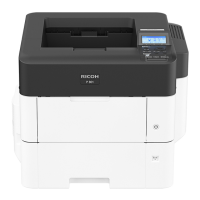Paper Feed Unit
Paper type and weight Paper size Paper capacity
64–120 g/m
2
(17 lb. Bond–
44 lb. Cover)
Plain Paper 1–Thick Paper 1
Select the paper size using the
paper size dial on the
tray:
A4 , A5 , 8
1
/
2
× 14 , 8
1
/
2
× 11 , 5
1
/
2
× 8
1
/
2
500 sheets
64–120 g/m
2
(17 lb. Bond–
44 lb. Cover)
Plain Paper 1–Thick Paper 1
Set the paper size dial on the
tray to "Asterisk", and select the
paper size with the control
panel:
B5 JIS , B6 JIS , 8
1
/
2
× 13 ,
8
1
/
4
× 14 , 8
1
/
4
× 13 , 8 ×
13 , 8 × 10 , 7
1
/
4
× 10
1
/
2
, 16K , 8
1
/
2
× 13
2
/
5
500 sheets
64–120 g/m
2
(17 lb. Bond–
44 lb. Cover)
Plain Paper 1–Thick Paper 1
Custom size:
Vertical: 162.0–356.0 mm
Horizontal: 92.0–216.0 mm
Vertical: 6.38–14.01 inches
Horizontal: 3.63–8.50 inches
500 sheets
Envelopes Set the paper size dial on the
tray to "Asterisk", and select the
paper size with the control
panel:
4
1
/
8
× 9
1
/
2
, 3
7
/
8
× 7
1
/
2
,
C5 Env , C6 Env , DL Env
*1
*1
When a print job is performed on A5 or 5
1
/
2
× 8
1
/
2
paper, it is recommended to set the paper horizontally.
While a print job is performed on paper that is loaded vertically, smearing may occur near the edges of the
printed paper. Also, use the bypass tray when printing on paper that is set horizontally.
*2
Do not stack paper over the limit mark. The maximum number of sheets you can set at once depends on the
paper's thickness and condition.
4. Adding Paper and Toner
86

